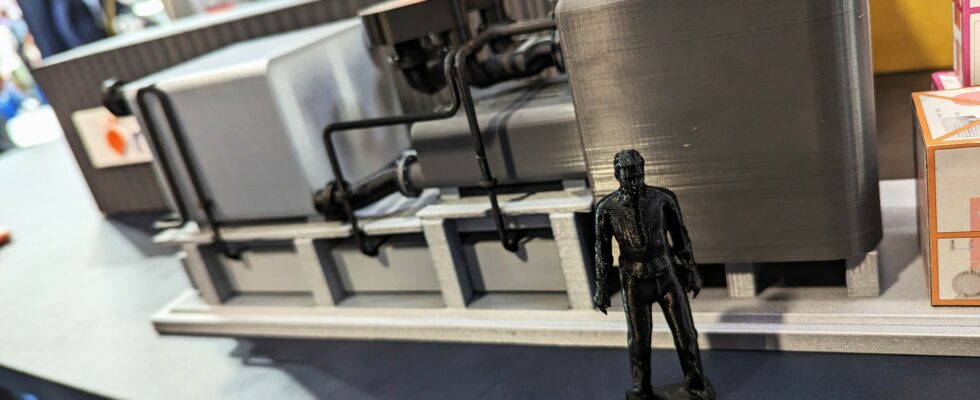The French start-up Naarea promises to provide very high temperature heat and controllable electricity, without CO emissions.2. His solution? A mini nuclear reactor of 4th ultra-compact generation, with a capacity of 40 megawatts of electricity.
In the much-needed race to decarbonize our energy production, a French company could well shake up the rules of the game. Founded in 2020, Naarea is developing a disruptive technology: fourth-generation mini-nuclear reactors, capable of producing heat extreme of 700°C and electricity on demand.
The idea? Recycle very long-lived nuclear waste from current power plants as fuel. These molten salt reactors, devoid of water, can be installed anywhere without risk of explosion. And their ultra-compact size, equivalent to a semi-trailer, allows them to be located as close as possible to industrial needs. Commercialization is expected from 2030. At VivaTech, we were able to discuss all this with the founder of the company, Jean-Luc Alexandre.
A pocket-sized, modular nuclear reactor, which should make it irresistible
Naarea has developed, with Dassault Systèmes and Assystem, the digital twin of a fourth generation nuclear power plant, a nuclear power plant which presents multiple advantages. The first of these is size. The small nuclear island, which is so compact that it fits into a container, measures 12 meters long by 3 meters wide. It only requires a security perimeter of 100 meters by 100 meters, sufficient to prevent activists or terrorists from crossing it, with then the same security requirements as a nuclear power plant.
The size of the small power station allows it to be installed practically in any surface, for example a building, outdoors or underground. The installation is immediately available to the industrialist, to whom it can directly supply heat, since there is no problem of transport. “ In addition, there is no need for civil engineering, because the only one used is for the anti-seismic concrete slab, on which the container is placed. », explains Jean-Luc Alexandre, the president and founder of Naarea, at the head of a team already made up of 250 people.
The small size is an argument for installation, but also for deconstruction. “ When we dismantle, we can remove everything, there will be nothing left. We can also add modules, as we would with Lego, if the structure grows “. You understand, we are therefore dealing here with a modular tool, capable of generating as much power as possible.
The operation of the small reactor detailed
The reactor core is the most important part of the installation: it is here that the nuclear reaction takes place. The heat is extracted with different stages of heat exchangers, and it leaves the container at 700°C in the liquid phase. On the other side, we suck up all the fission gases produced, so as not to pollute the neutron reaction inside, nor to have pressure in the reactor, ” so you extract the gases, you treat them and store them in the solid phase », adds Jean-Luc Alexandre.
The heart is made of a material, a ceramic, which is very important. It allows you to manufacture elements using 3D printing. “ There is no more welding, this is the great nuclear challenge of tomorrow. Welding is avoided as much as possible. “.
The mini-power plant does not need water to operate, a blessing for the environment
In addition to the advantage of its small size, the small Naarea reactor has another beneficial feature, a major ecological argument. “ Water is sacred, it is a resource that must be preserved », Reminds us Jean-Luc Alexandre. “ All the reactors in the world are cooled mainly with water, because they need to be cooled continuously, but also in the event of loss of all the equipment around them, what we call the “residual power” “.
Here, the reactor is so small that Naarea was able to show that water was simply not necessary for its operation. Instead, the start-up evacuates the residual power with a heat exchange with the air, “ what we call “natural convection”, which is a game changer “. The small size makes this possible. “ If the reactor becomes larger, we then reach a limit, which pushes us to switch back to water “, which is absolutely not the desired goal, says Jean-Luc Alexandre.

Naarea has also done the same thing on the second container, which transforms heat into electricity. “ It’s not a steam turbine, it’s a CO turbine2 supercritical. That’s good, there are plenty of them in the air “. Closed circuit operation ensures that no CO is released.2. Summary of the races: Naarea uses gas in abundance in the atmosphere, while preserving water, a resource set to become ever more scarce.
Power, autonomy and maintenance, the Naarea mini-nuclear reactor does not pretend
The Naarea power station has a capacity of 80 megawatts (MW) thermal (to generate heat), or 40 MW electrical. “ This is the electrical power of the residential needs of a city of 250,000 inhabitants, such as Bordeaux for example. », Illustrates Jean-Luc Alexandre, former director of new technologies (CTO) of the giant Suez, for infrastructure. It is also the power of the largest industrial islands. A nuclear island, remember, is the whole which includes the nuclear boiler, the installations linked to the fuel, and the equipment necessary for the operation and safety of the whole.
Concerning autonomy, the charge should last around 5 years on average. The containers were designed for a period of 100 years, with an operating period of 50 years. Every 10 years, as with airplanes, each mini-reactor will be returned to the factory to be refurbished.
Regarding maintenance, Naarea explains to us that the nuclear part will be controlled remotely. During the first five years, there will be no maintenance on the nuclear island. On the external part, with the turbine, regular maintenance is planned, without interruption. “ Everything has been designed as a plug-and-play system », summarizes Jean-Luc Alexandre. 5,000 sensors should make it possible to monitor the progress of reactor maintenance in real time.
Naarea is not stopping there and is developing, with a start-up from the CEA (Atomic Energy Commission), a laser which will make it possible to measure, in real time, the inventory of the elements it contains. is in molten salts. “ When you do fission, you constantly create elements, but you don’t know which ones, there is a distribution statistic. There, the instrument will take the measurement and tell you “here is the inventory at this time” “.
Calendar, price, interest in the mini-reactor: details from Naarea
Ideal complement to renewable energies, “ whose intermittency is the Achilles heel », the small reactor, which no longer requires storing energy, will lead to the construction of a physical twin, with a first prototype hoped for in 2027. A nuclear prototype will follow in 2028, then a commercial prototype, the first of series, hoped for in 2029-2030.
Naarea will work as designer, manufacturer and operator-maintainer of the reactor, of which the start-up will manufacture parts and order the remaining parts from European suppliers. This way, the French entity is not dependent on any supply chain and can reduce its costs.
Moreover, the company promises to provide energy at competitive rates. “ We guarantee a price for carbon-free electricity lower than anything that exists today, non-intermittent, I insist. If we want to decarbonize, we have to be competitive », adds Jean-Luc Alexandre. The manager claims to have already sold 20% of production over 20 years, to customers from all sectors. ACC and its Northern battery gigafactory are part of this. The story has only just begun for Naarea.


4